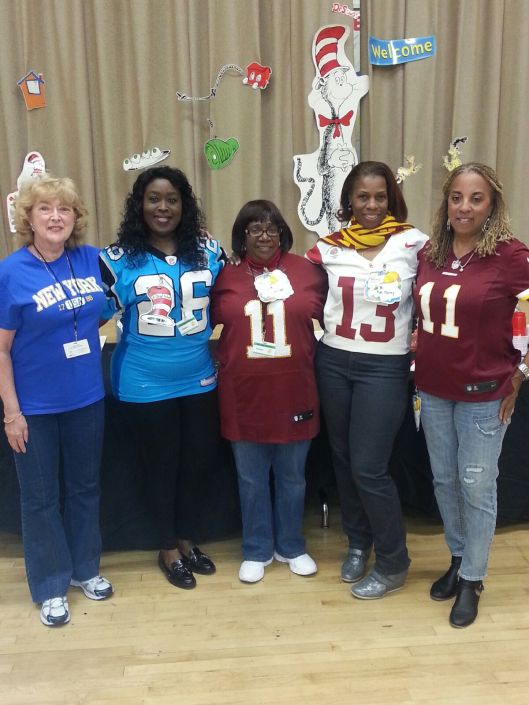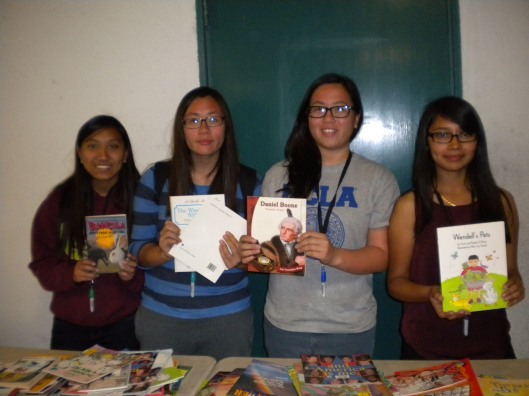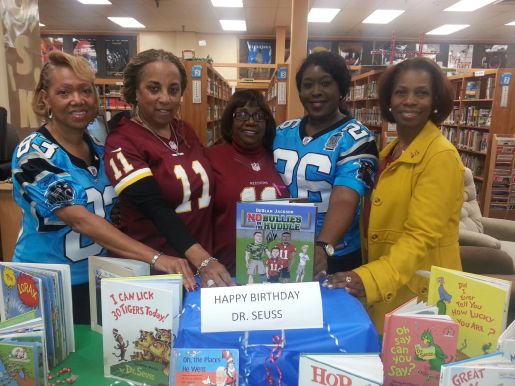
2015 National Women’s History Month Honorees
Weaving the Stories of Women’s Lives

March is National Women’s History Month. 2015 is the National Women’s History Project’s 35th Anniversary. In celebration of this landmark anniversary, the DeSean Jackson Foundation has chosen 4 women as 2015 Honorees who have contributed in very special ways to “writing women back into history.” Collectively, their creations reveal the depth and breadth of the multicultural female experience. They have woven women’s stories into the fabric of our history and society. – Gayle Jackson, President, The DeSean Jackson Foundation.
Dr. Audrey Forbes Manley (1934 -)
 Dr. Audrey Forbes Manley became the first alumna to lead her beloved alma mater when she was appointed Spelman College’s eighth president in 1997. Dr. Manley’s unwavering dedication, experience, and intimate knowledge of the institution served Spelman well as she successfully guided the College into the New Millennium.
Dr. Audrey Forbes Manley became the first alumna to lead her beloved alma mater when she was appointed Spelman College’s eighth president in 1997. Dr. Manley’s unwavering dedication, experience, and intimate knowledge of the institution served Spelman well as she successfully guided the College into the New Millennium.
Dr. Forbes Manley was born in Mississippi in 1934. She spent her early years there before moving to Chicago, where she graduated from Wendell Phillips High School in 1951. She earned her bachelor’s degree as a member of Spelman’s Class of 1955, and immediately continued her education at Meharry Medical College in Nashville, Tenn. After receiving her medical degree in 1959, she returned to Chicago where she completed her residency at Cook County Children’s Hospital in 1963. At 27, she was the first woman, second African-American, and the youngest person to be named chief resident physician at the hospital’s pediatric division. After working at the North Lawndale Neighborhood Health Center, Dr. Manley served two years as the assistant medical director at the Woodlawn Child Heath Center; then relocated to San Francisco where she practiced pediatric medicine at Mt. Zion Medical Center. She also held several faculty positions at the University of Illinois, the University of Chicago, and the University of California.
In 1966, Dr. Manley was elected to Spelman’s Board of Trustees and served from 1966 to 1970. In 1991 Dr. Manley received an honorary doctor of laws degree from Spelman College.
In 1970, she married Dr. Albert Manley, Spelman College’s fifth president, and became the first lady of her alma mater until her husband’s retirement in 1976. As first lady, she initiated the Health Careers Office and chaired the Health Careers Advisory Committee. She also served as an organizer and consultant of the Family Planning Program and Initiative for College Personnel in Family Planning and as medical director of the Family Planning Program for the Atlanta University Center.
During this time, her medical career continued to flourish. She served as chief of medical services at Grady Memorial Hospital’s Emory University Family Planning Clinic in Atlanta. In 1976, she became a captain in the U.S. Public Health Service and in 1987 earned a master’s degree in public health from Johns Hopkins University.

Dr. Manley was the first African-American woman appointed principal deputy assistant secretary for health in the U.S. Public Health Service. She served as deputy U.S. surgeon general in 1994, and acting U.S. surgeon general from 1995 to 1997. Following Dr. Albert Manley’s death in 1997, Dr. Audrey Forbes Manley returned to Spelman – this time as president. She led the College for five successful years before retiring and becoming president emerita.
Historical Highlights During Dr. Manley’s Presidency
- Under Dr. Manley’s administration the College had a balanced budget and an increased asset growth of more than $30 million; and a physical plant growth of more than $50 million. The College endowment grew more than $63 million; and she raised more than $70 million in private and federal funds.
- In 1998, Spelman was awarded a chapter of Phi Beta Kappa, the nation’s premier honor society. During the same year, the school became a provisional member of NCAA Division II in basketball, volleyball, cross-country, tennis, and track and field.
- The College continued to receive several top rankings including No. 1 by Black Enterprise as best environment for Black collegians; No. 2 on the fifth annual list of Top Ten Activist Schools by Mother Jones Magazine in 1998; and No. 2 by the Association of Medical Colleges in placing African-American students in medical school.
- In 2001, the Division of Media and Information Technology was established.
- Professor Ayoka Chenzira, internationally noted filmmaker and visual artist, was the first recipient of the William and Camille Cosby Endowed Professorship in the Fine Arts in 2001. Dr. Bernice Johnson Reagon, C’70, cultural historian and founder of legendary a cappella group, Sweet Honey in the Rock, was named the 2002 Cosby Professor in the Fine Arts and Dr. Shelia Walker, nationally known anthropologist and scholar became the 2002 Cosby Professor in the Humanities.
- Spelman hosted the 25th International Association of Philosophy and Literature Conference in May 2001. The event marked the first time a historically Black college hosted the conference.
- Several renovations took place on the campus including Upper and Lower Concourses and Dining Services in the Manley College Center, and The Albro Falconer Manley Science Center dedicated in 2002. The Science Center was named partly in Dr. Audrey Manley’s honor.
Gladys Tantaquidgeon (1899-2005)
Mohegan Medicine Woman, Anthropologist, and Tribal Elder

In my early years, I wasn’t aware that time was going so rapidly …
later I realized many of our old people were dying and their knowledge
went with them. Something had to be done to preserve a record of
their way of life. My goal has always been that this information …
be passed on to future generations. Gladys Tantaquidgeon
Gladys Tantaquidgeon’s life spanned the entire 20th century. She grew up in the Mohegan community (Uncasville, Connecticut) learning traditional practices, beliefs, and herbalism. She only completed grade school but at age 20 she took the opportunity to study anthropology at the University of Pennsylvania. She completed extensive field research on east coast Indian tribeal cultures and herbal medicines and published several books based on her research. In 1931, she co-founded Tantaquidgeon Museum with her brother and father; it remains the oldest American Indian owned museum in the U.S.
In 1934, Tantaquidgeon started work with the Bureau of Indian Affairs and for the next 10 years she provided social services and worked as a native arts specialist in Native American communities in the north central U.S. She became an expert in preserving and reviving traditional practices that had been forbidden or lost in the 19th century. During the 1940s she also worked as a librarian in a Connecticut women’s prison, where she used skills gained from her previous work helping struggling Native women.
In 1947, Tantaquidgeon began working as the full time curator for her family’s museum. For the next 50 years she introduced visitors to her tribe’s history and traditions through a collection of artifacts and crafts. The museum was created under the assumption that “you can’t hate someone you know a lot about.” In her later years, she served on the Mohegan Tribal Council and continued her work as a medicine woman. Throughout her life Tantaquidgeon collected tribal records and documents that in 1994 proved to be critical to the success of the Mohegan Tribe’s decades-long campaign to gain federal recognition.
Darlene Clark Hine (1947- )
Historian and Educator

Receiving the 2013 National Humanities Medal… was both a blessing
and a profound moment in the history of Black Women’s History
because it represented acknowledgement and appreciation
of the work that I and my generation of scholars did to include
the contributions that black women have made to our nation’s
progress and to the global struggle against social injustice,
and economic and gender inequality. Darlene Clark Hine
As an historian Darlene Clark Hine sought not only to explore African American history, but to expand the discipline of history itself by focusing on black women “who remained at the very bottom of the ladder in the United States.” A leading expert on the subject of race, class, and gender in American society, Hine is credited with helping to establish a doctoral field in Comparative Black History at Michigan State University.
While attending Chicago’s Roosevelt University in the sixties, Hine says it was “hearing black activists refer so often to history, seeing the black culture celebrated by artists, and reading new works by black writers “that inspired her with the hope that someday she could change the very definition of “history.”
“Historians can write a history of anything or anyone,” Hine is quoted as saying, “but apparently few considered black women worth the telling.” Hine herself had to be persuaded to explore the lives of African American women in Indiana, but soon became convinced that US history was leaving out far too much that was important to nurture a comprehensive understanding of American society. Thus her preliminary research on women’s roles in churches, and other settings led to brief monograph, When the Truth Is Told: Black Women’s Community and Culture in Indiana, 1875-1950 (1980).
“If I can…impress upon the historical profession” she once insisted, “how important it is to talk to and illuminate the lives of people who did not leave written records, but who also influenced generations of women all over the globe, then I will feel that my career is worthwhile.”
Vicki L. Ruiz (1955 – )
Educator and Pioneer in Latina History

For me, history remains a grand adventure,
one which began at the kitchen table listening
to the stories of my mother and grandmother and
then took flight aboard the local bookmobile. Vicki Ruiz
The first in her family to receive any advanced degree, Vicki L. Ruiz earned a Ph.D in History at Stanford in June 1982. Two months later she showed up for her first teaching position with a baby on her hip and another on the way. Over the course of three decades, Ruiz has been a major force in shaping the field of Chicana history.
In 2012, when she became the first Latina historian inducted into the American Academy of Arts and Sciences. Her commendation recognized her pioneering scholarship and leadership “skillfully blending insights from the history of women, of workers, and from the arena of ethnic studies.” Ruiz has inspired generations of students and scholars to integrate this large and complex ethnic group into the broad tapestry of American history.
Over the course of three decades, Dr. Ruiz has published over fifty essays and one dozen books including Cannery Women, Cannery Lives and From Out of the Shadows: Mexican Women in Twentieth- Century America. Her edited or co-edited collections include Unequal Sisters: An Inclusive Reader in U.S. Women’s History and the three-volume, Latinas in the United States: A Historical Encyclopedia. Dedicated to the people whose lives she writes back into history, Ruiz, explains: “As a historian, I have had the privilege of interviewing people whose quiet courage made a difference in their lives and in their communities.”





 Dr. Audrey Forbes Manley became the first alumna to lead her beloved alma mater when she was appointed Spelman College’s eighth president in 1997. Dr. Manley’s unwavering dedication, experience, and intimate knowledge of the institution served Spelman well as she successfully guided the College into the New Millennium.
Dr. Audrey Forbes Manley became the first alumna to lead her beloved alma mater when she was appointed Spelman College’s eighth president in 1997. Dr. Manley’s unwavering dedication, experience, and intimate knowledge of the institution served Spelman well as she successfully guided the College into the New Millennium.



























































